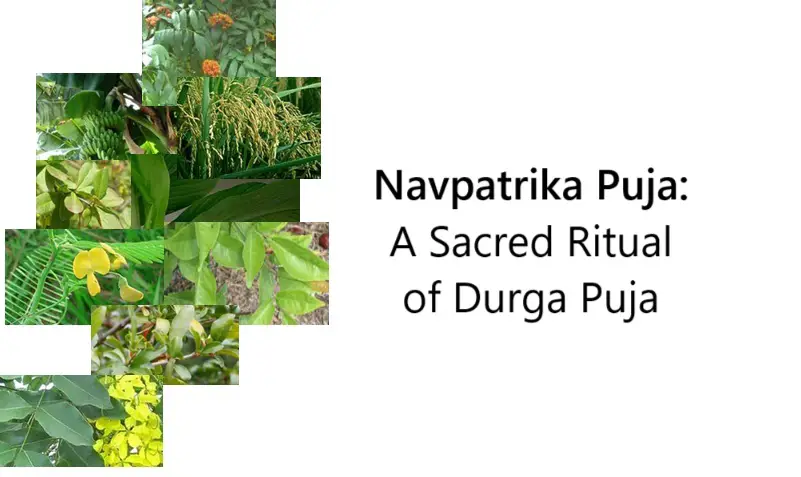
Introduction
Navpatrika Puja, also known as Maha Saptami, is an essential ritual observed during Durga Puja. This unique tradition involves the worship of nine sacred plants, collectively referred to as Navpatrika. It is primarily celebrated in West Bengal, Assam, Tripura, Odisha, and parts of Bihar and Jharkhand. The ritual is deeply rooted in agrarian culture, symbolizing nature’s bounty and the divine power of Goddess Durga.
Origins and Significance
The word “Navpatrika” is derived from Sanskrit, where “Nav” means nine and “Patrika” means leaves or plants. This practice can be traced back to ancient Hindu traditions that emphasize the worship of natural elements. In Durga Puja, Navpatrika represents the nine forms of Goddess Durga, embodying different aspects of divine energy and protection. The ritual is also linked to agricultural prosperity, reflecting the deep connection between nature and spirituality.
The Nine Sacred Plants and Their Divine Associations
Navpatrika consists of nine plants, each symbolizing a different deity and aspect of nature:
- Banana Plant (Kadali Patra) – Represents Goddess Brahmani, who grants wisdom and intelligence.
- Turmeric Plant (Haldi Patra) – Symbolizes Goddess Durga, known for her protective and healing powers.
- Jayanti Plant (Jayanti Patra) – Associated with Goddess Kartiki, representing victory and success.
- Wood Apple Leaves (Bilva Patra) – Represents Lord Shiva, symbolizing purity and devotion.
- Pomegranate Leaves (Dadhi Patra) – Signifies Goddess Rakta Dantika, associated with power and transformation.
- Ashoka Leaves (Ashoka Patra) – Linked to Goddess Shokarahita, bringing happiness and freedom from sorrow.
- Arum Plant (Kachu Patra) – Represents Goddess Chamunda, symbolizing fierce protection against evil.
- Rice Paddy (Dhan) – Symbolizes Goddess Lakshmi, the bestower of wealth and prosperity.
- Sesame Plant (Til Patra) – Associated with Goddess Shakti, embodying energy and strength.
Each of these plants is revered for its spiritual and medicinal significance, reinforcing the idea that divine blessings are present in nature.
Rituals and Procedures of Navpatrika Puja
Navpatrika Puja is performed on the seventh day (Saptami) of Durga Puja with great devotion. The rituals involve multiple steps:
- Collection and Cleansing of Plants – The nine plants are carefully gathered before dawn. Devotees cleanse them thoroughly to remove impurities and ensure sanctity.
- Binding the Plants Together – The plants are tied together with a white thread, forming a unified representation of Goddess Durga’s divine power.
- Holy Bath (Snan) Ritual – The bound Navpatrika is taken to a sacred river or water body for a ceremonial bath while priests chant Vedic hymns. This act purifies the plants and invokes their divine energies.
- Dressing the Navpatrika – After the bath, the Navpatrika is draped in a red or white sari with a red border, resembling a newlywed bride. This tradition has earned it the name “Kolabou” (banana bride) in Bengal.
- Installation and Worship – The Navpatrika is placed to the right of Goddess Durga’s idol in the puja pandal. Priests perform elaborate rituals, offering flowers, incense, fruits, and sweets while reciting sacred mantras.
Symbolism and Cultural Importance
Navpatrika Puja holds profound spiritual and cultural significance. The ritual represents the unification of various deities into a single divine force, emphasizing the balance of nature and spirituality. It also acknowledges the importance of agriculture and expresses gratitude for nature’s resources.
In contemporary times, while the core rituals remain unchanged, the festival has evolved to include community gatherings, artistic performances, and cultural programs. The observance of Navpatrika Puja fosters a sense of unity and devotion among devotees.
Conclusion
Navpatrika Puja is a testament to the deep connection between nature and divine worship in Hindu traditions. Through the veneration of nine sacred plants, devotees seek blessings for prosperity, protection, and spiritual growth. This ritual not only honors the divine feminine energy of Goddess Durga but also reinforces the significance of nature in sustaining life. By preserving and practicing these age-old traditions, devotees continue to celebrate the divine presence in all aspects of existence.




